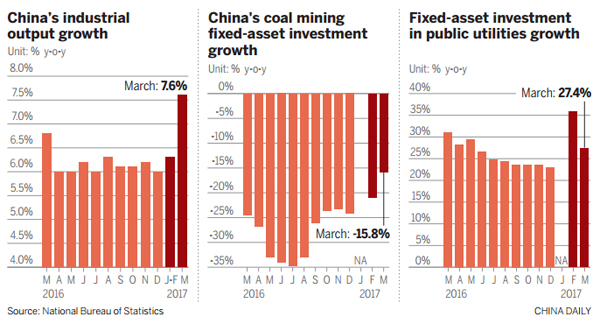


China has made new progress toward carrying out supply-side structural reform in the first quarter of the year, the National Bureau of Statistics said on Monday. Analysts said a balance should be struck between pushing forward reform and achieving stable economic growth.
Supply-side structural reform-as measures to raise efficiency, including cutting overcapacity, reducing inventories, deleveraging, lowering costs and strengthening weak links-have made much headway in the first three months of this year, said NBS spokesman Mao Shengyong.
The capacity use rate of major industrial firms, which measures the efficiency of corporate operations, rose 2 percentage points from the fourth quarter of last year to 75.8 percent in the January-March period, while coal output dropped 0.3 percent year-on-year, the NBS said. The amount of unsold commercial housing space fell by 6.4 percent year-on-year, 3.2 percentage points higher than at the end of last year, it added.
The asset-liability ratio of industrial enterprises dropped by 0.6 percentage point year-on-year to 56.2 percent in the first quarter. And the country's fixed-asset investment in ecological system protection, public utilities, agriculture, and water conservancy management increased by 48.1 percent, 27.4 percent, 24.6 percent and 18.3 percent, respectively, in the same period. All were higher than the overall fixed-asset investment growth of 9.2 percent.
"Supply-side structural reform has played a role in boosting the stable growth of the national economy," said Zhang Siping, founder of the Innovation and Development Institute, a Shenzhen-based independent think tank. "The relationship between stable growth and structural reform should be properly handled."
Central and local governments should better coordinate cost reductions when carrying out supply-side structural reform, said Feng Qiaobin, an economics professor at the Chinese Academy of Governance.
For example, in cutting taxes, local governments should have access to stable fiscal revenue sources so that they would not take other reform-offsetting measures to replenish the local coffers after their fiscal revenues decrease.
China's economic structure has also become balanced and new drivers for growth are posting a stronger presence in the first quarter, according to NBS data.
The nation's industrial structure is increasingly dominated by the services sector and consumption, shifting away from the previous reliance on investment.
In the first quarter, the added value of the tertiary sector accounted for 56.5 percent of GDP, 17.8 percentage points higher than that in the secondary industry.
 Fire brigade in Shanghai holds group wedding
Fire brigade in Shanghai holds group wedding Tourists enjoy ice sculptures in Datan Town, north China
Tourists enjoy ice sculptures in Datan Town, north China Sunset scenery of Dayan Pagoda in Xi'an
Sunset scenery of Dayan Pagoda in Xi'an Tourists have fun at scenic spot in Nanlong Town, NW China
Tourists have fun at scenic spot in Nanlong Town, NW China Harbin attracts tourists by making best use of ice in winter
Harbin attracts tourists by making best use of ice in winter In pics: FIS Alpine Ski Women's World Cup Slalom
In pics: FIS Alpine Ski Women's World Cup Slalom Black-necked cranes rest at reservoir in Lhunzhub County, Lhasa
Black-necked cranes rest at reservoir in Lhunzhub County, Lhasa China's FAST telescope will be available to foreign scientists in April
China's FAST telescope will be available to foreign scientists in April "She power" plays indispensable role in poverty alleviation
"She power" plays indispensable role in poverty alleviation Top 10 world news events of People's Daily in 2020
Top 10 world news events of People's Daily in 2020 Top 10 China news events of People's Daily in 2020
Top 10 China news events of People's Daily in 2020 Top 10 media buzzwords of 2020
Top 10 media buzzwords of 2020 Year-ender:10 major tourism stories of 2020
Year-ender:10 major tourism stories of 2020 No interference in Venezuelan issues
No interference in Venezuelan issues
 Biz prepares for trade spat
Biz prepares for trade spat
 Broadcasting Continent
Broadcasting Continent Australia wins Chinese CEOs as US loses
Australia wins Chinese CEOs as US loses